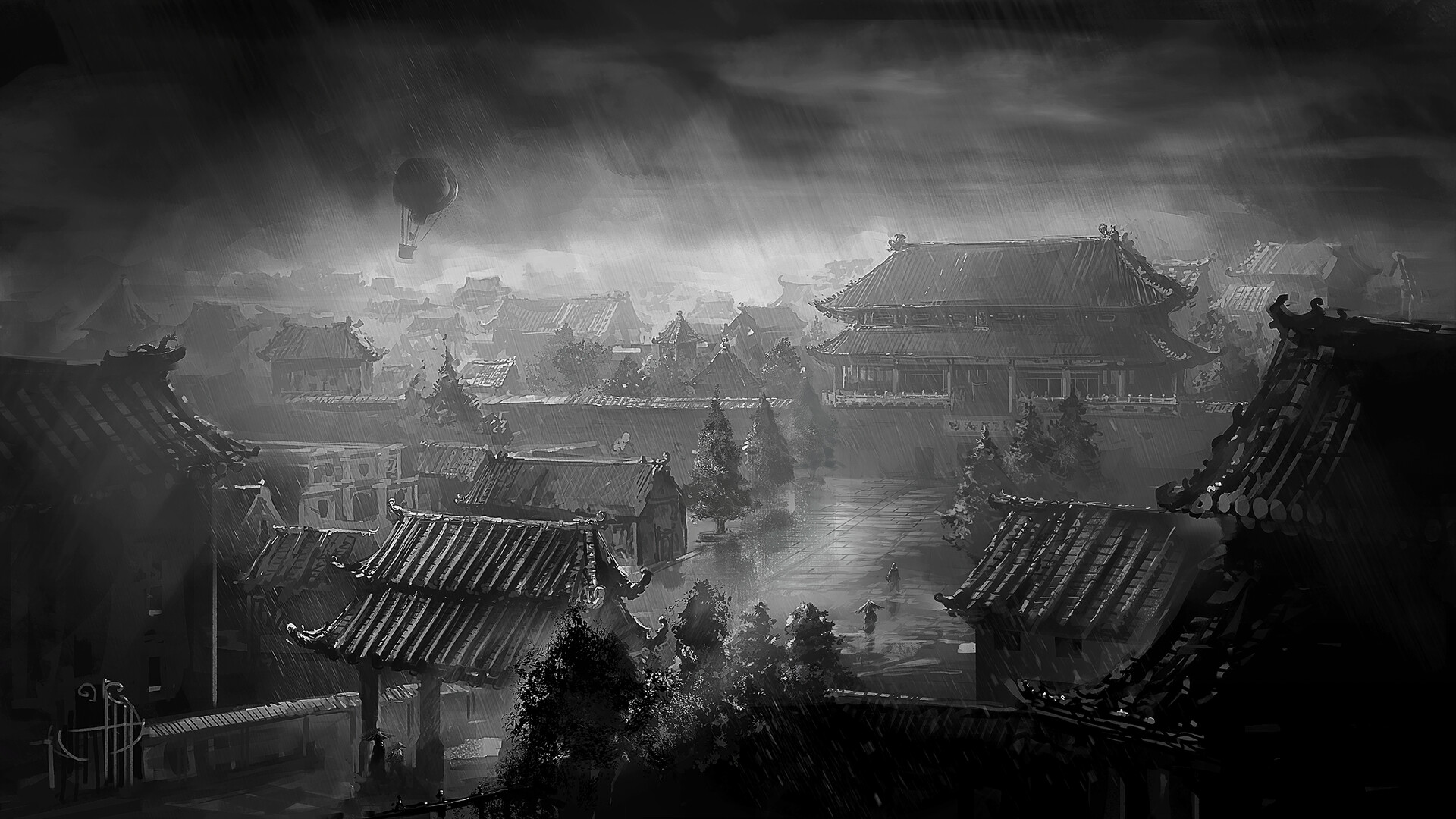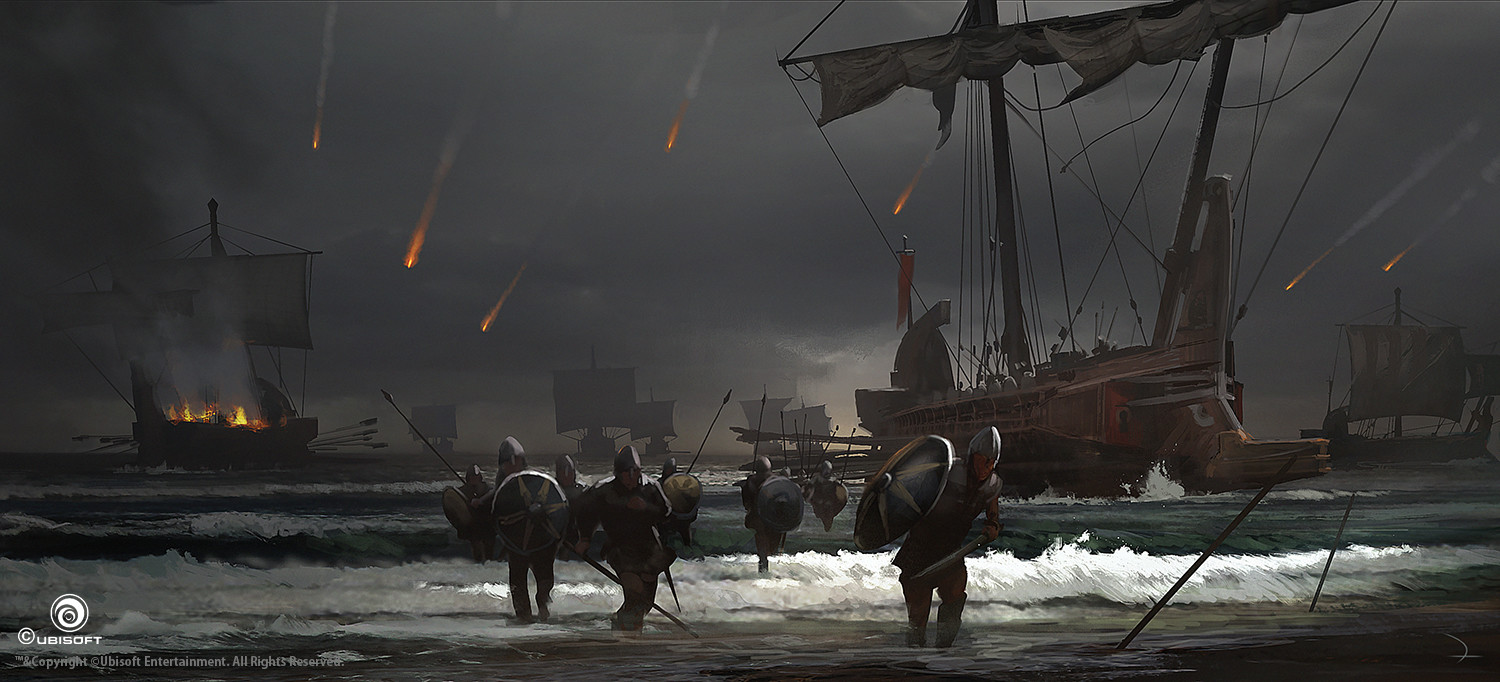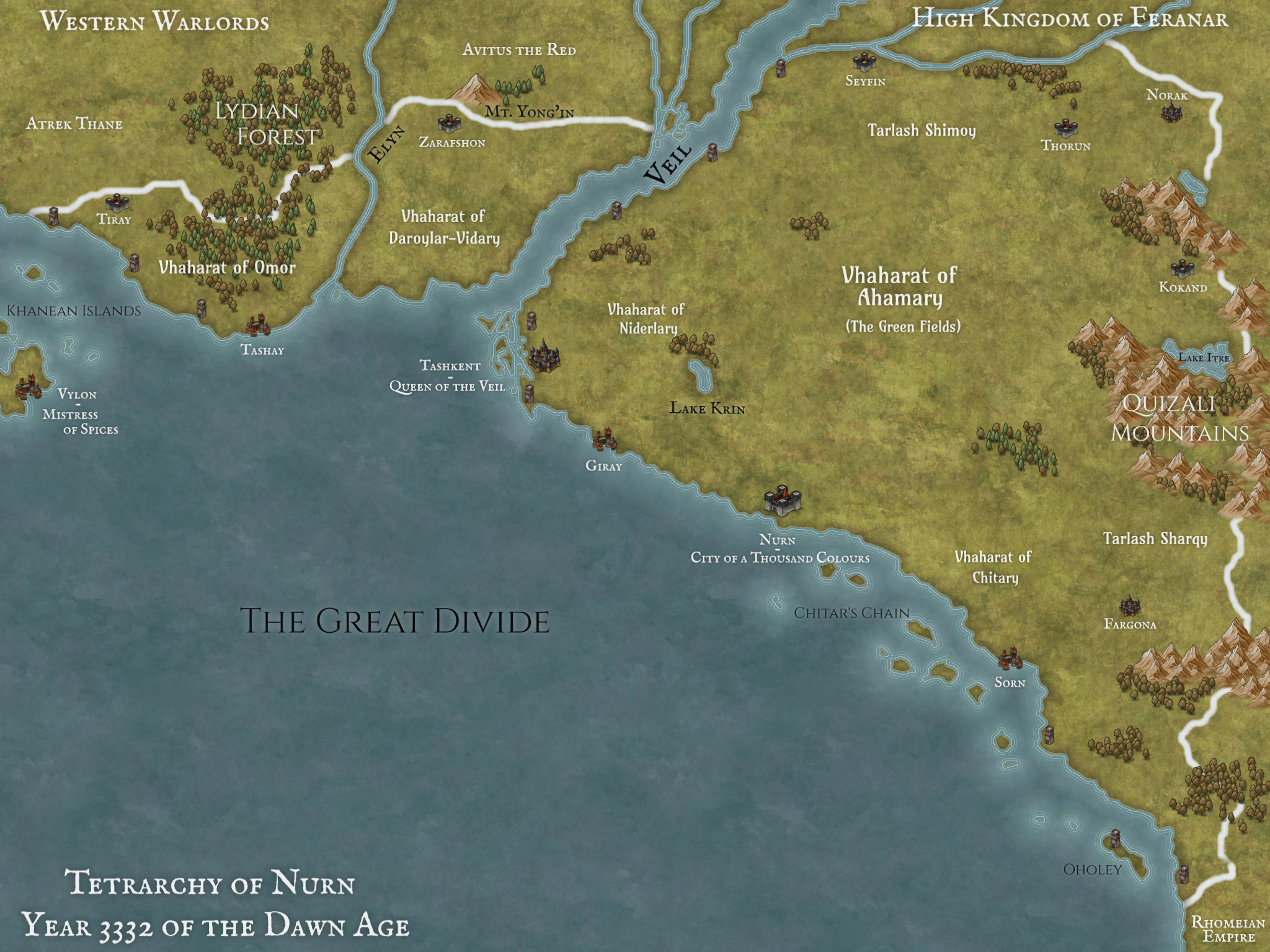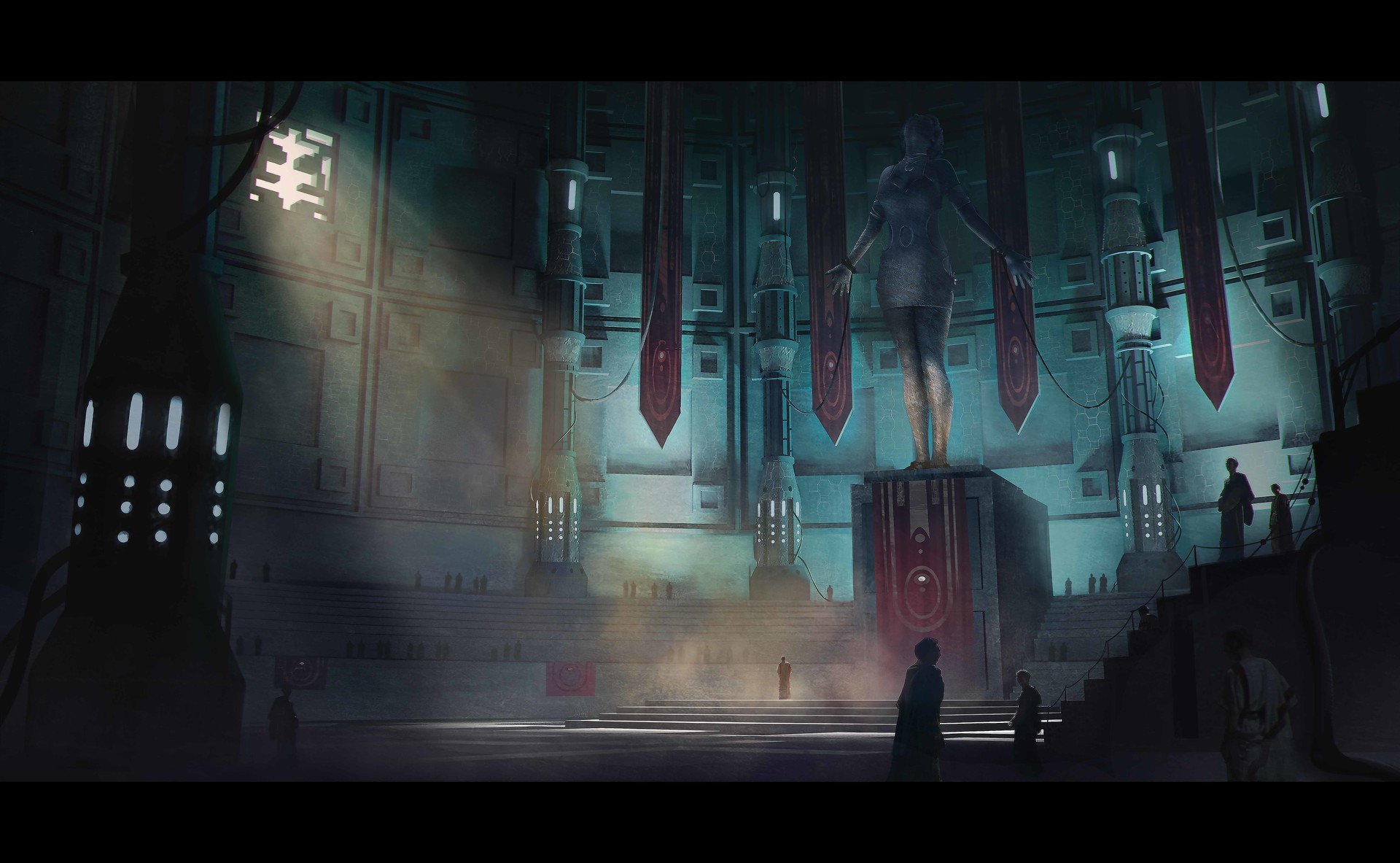Tetrarchy of Nurn
You notice immediately that you aren't in Helenia anymore. This is a very different place. A piece of a forgotten world, kept alive here in Vardania.
Many consider the far south of Vardania to be an "exotic" corner. A cabinett of curiosities of sorts, where the people strangest to the average Vardanian dwell. None may seem stranger than the Mykarans who have created for themselves a small corner of paradies in a foreign land.
Geography
Nurn stands as the largest realm of the Summer Coast at present. It covers the flat coastal plain on both sides of the mighty, mist-covered river Veil , reaching east into the foothills of the Quizali Mountains and north to where the land rises into the rough, pine-covered platue of Ironwood. In the west, the Lydian Forest marks the border. Outside that great wooden realm, there are few trees left in Nurn proper after millennia of human activity. The endless plain is only broken by the eastern mountains and the sharp, near vertical cut that marks the beginning of the Great Divide, these sheer blackened cliffs only broken in a few places where the harbour cities of Nurn reside.History and Government
Every state's government is formed by its history and nowhere does this prove truer than in Nurn. The Tetrarchy was born from a bloody rebellion in 1530 DA, when the Mykarans rose up against the Daughters of Cybelle, a vile cult that had originally founded the city of Nurn as a base to further their campaigns of conquest. When Ameris the Pure achieved her final victory in 1542 DA, she built her new nation from the ground up. At its core, the Tetrarchy is built in defiance and imitation of the old order that dominated the Mykaran people in mind and body.Tetrarchy
Power in the Tetrarchy is split between three individuals, each a descendant of either Ameris the Pure or one of her companions. These three queens control every aspect of Nurnese society, the first responsible for military and security, the second for trade, sanitation and health, and the third for infrastructure and maintenance. While each is able to act on her own, the three will usually meet to discuss larger issues. A fourth spot exists in name only. Reserved for a long dead goddess it serves as a reminder of the realm's darker origins.
Power in the Tetrarchy is split between three individuals, each a descendant of either Ameris the Pure or one of her companions. These three queens control every aspect of Nurnese society, the first responsible for military and security, the second for trade, sanitation and health, and the third for infrastructure and maintenance. While each is able to act on her own, the three will usually meet to discuss larger issues. A fourth spot exists in name only. Reserved for a long dead goddess it serves as a reminder of the realm's darker origins.
Matriarchy
The Mykarans are one of the few fully matriarchal societies in the world. And while the Mykarans have moved on from the oppressive and total version practiced by the Daughters, women very much still rule every aspect of their society. Men have been allowed into higher and higher positions as the centuries have moved on, but the highest echelons still remain open only to the fairer of the sexes. An order that has been shaken to its very core by the ascendancy of the first male First Queen in Griskar I. in 3328 DA.
The Mykarans are one of the few fully matriarchal societies in the world. And while the Mykarans have moved on from the oppressive and total version practiced by the Daughters, women very much still rule every aspect of their society. Men have been allowed into higher and higher positions as the centuries have moved on, but the highest echelons still remain open only to the fairer of the sexes. An order that has been shaken to its very core by the ascendancy of the first male First Queen in Griskar I. in 3328 DA.
Bureaucracy
Hailing from the continent of Scetia the Mykarans have remained decidedly western in many of their ideas and approaches. Their bureaucracy is a highly tiered and near-labyrinthine system designed to have every issue dealt with by a specialist. To gain entry, one has to undergo a year-long examination process.
Battle for Survival
The Mykaran's role in the Cult Invasions of Vardania has not been forgotten. To this day, they remain somewhat of an outsider in the wider community of the continent. That the state has returned to its imperialistic roots at several points has not helped matters and the Nurnese face numerous threats.
Feran aggression is the most prominent of those, be it in form of the reborn High Kingdom of Feranar or the many Warlords that have risen across western Vardania in the wake of imperial decline. Pressure on the Tetrarchy's borders is constant the threat of a larger war looms over the heads of the four queens.
Another threat lurks west. Barely three days ship travel from Nurn lies Vylon, the Mistress of Spices and one of the great merchant cities of the Summer Coast. Its rivalry with Nurn is ancient and bloody, the cities having engaged in two major wars between 3300 and 3329 DA. And another is sure to follow.
You study for five years to take a year-long exam after which you study another three years to take another year-long exam. All in a single field and that day in and day out. No wonder so many of them go mad before they even take the exam.
Economy and Internal Structure
The Tetrarchy is divided into a total of seven provinces, five prefectures known as Vhaharat and two marches known as Tarlash. All of them originate in the organisation of the old Mykaran Army, with the three original Vhaharats serving as the bases for its three main regiments. Smaller subdivisions were based on which company was located where, almost all of the older cities in Nurn having been founded as garrisons. What distinguishes a Tarlash is that they are solely military in nature, with even the civilian population living under army law and serving as reservists in case of war. The Vhaharats on the other hand have taken on a more civilian nature over the years with merely the various office names still giving credence to their military origin.Agriculture
For much of its time, the realm was mostly agriculture based with the Vhaharat of Ahamary encompassing the largest and most fertile areas. This gave its commander an incredebly strong position was the cause of several civil wars. As Nurn's reliance on agriculture ceased so did the Vhaharat's power.
For much of its time, the realm was mostly agriculture based with the Vhaharat of Ahamary encompassing the largest and most fertile areas. This gave its commander an incredebly strong position was the cause of several civil wars. As Nurn's reliance on agriculture ceased so did the Vhaharat's power.
Lumber
Wood has become the engine of the Tetrarchy, serving to maintain its might fleet and industry. This has left a stark mark on the landscape with barely any larger natural forests left. As of 3300 DA, the need for new sources has grown so strong that it forced the realm to expand west, into the Lydian Forest.
Wood has become the engine of the Tetrarchy, serving to maintain its might fleet and industry. This has left a stark mark on the landscape with barely any larger natural forests left. As of 3300 DA, the need for new sources has grown so strong that it forced the realm to expand west, into the Lydian Forest.
Martime Trade
Beginning in the 2000s DA, Nurn established a massive network of trading posts around the world. Cultural connections with the west helped it build its position there and few are as active in Scetian trade as the Nurnese. A mighty fleet of nearly 1,000 warships ensures this network's safety actoss the world.
Beginning in the 2000s DA, Nurn established a massive network of trading posts around the world. Cultural connections with the west helped it build its position there and few are as active in Scetian trade as the Nurnese. A mighty fleet of nearly 1,000 warships ensures this network's safety actoss the world.
Remnant of the Old Order
One of the core characteristics of both Mykaran society and the Tetrarchy itself is their militarized character. From the architecture of its cities, the structure of the realm, the titles given out to the fact that every Nurnese citizen has to serve at least three years in some military capacity. Eligible from the age of 15, the men and women of Nurn either train as frontline soldiers or in a support role. Once their tenure is over, they may continue on with an army career or leave to pursue other avenues. They will remain on the reserve list, however, and can be called upon should circumstances necessitate it. Due to this unique system, the Tetrarchy has one of the potentially largest armies on the Divide.Its a country where every blade of grass may hide one of steel, if you push them hard enough. If you really want to launch a full-scale invasion of the Tetrarchy, you better be ready for what awaits.

Founding Date
1530 DA
Type
Geopolitical, Queendom
Predecessor Organization
Government System
Monarchy, Absolute
Related Ethnicities
Above: Current banner of the Tetrarchy. Official flag of the state since the reign of Chitar XI. 2901-2943 DA, it shows the core truth of the Tetrarchy: to remove itself from the lies of Cybelle.
The Goddess is dead. Her eyes purged from our city. Let it remain that way until the end of time.From One to Many
What followed the Mykaran rebellion against the Cult in 1540 DA was a wholesale purge of the old religious system. Every temple, altar and figure depicting the abhorred Cybelle was torn down and burned. To cement this new age and prevent the old influences from returning, Ameris the Pure sought to create a state-sanctioned polytheistic society.
Everyone is free to worship who they want in the Tetrarchy, barring Cybelle, and a council of various religious representatives keeps watch over the relations between the at times drastically different faiths. While the system is not perfect it has kept Nurn save from the tainted hands of its ancient Mother Goddess. And that is all that matters.
Current Day: Diarchy and a Male Queen
The main challenges facing Nurn in the modern age are twofold. First is the growing hostility between the capital city of Nurn and the major trade city of Tashkent. The latter, a major hub for trade up the Veil river and nearly equal to Nurn in size, has been a rival of the capital in an endless contest for income, prestige and even the nature of the Tetrarchy itself. Escalation could pose the danger of throwing the realm into civil war.
The second is no less pressing. Griskar I., first male Queen of Nurn, has set on the throne for barely a year. While his ascension was a necessity to continue the line of Ameris the Pure, there are many that balk at this break with the very system Nurn is based on. Opposition to Griskar is growing in every corner of the realm and it may not be long before more drastic action is taken.
Remove these ads. Join the Worldbuilders Guild






I feel like Griskar needs to watch his back. D: Really interesting article. I love the details of the resources and economy too.